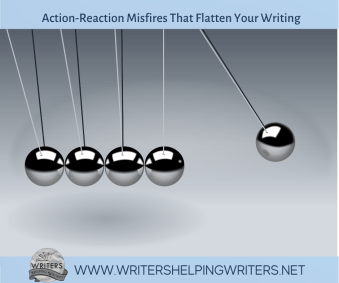3 Action-Reaction Misfires That Flatten Your Writing

Cause and effect. Stimulus and response. Action and reaction. Everything in a story depends on what the characters do about whatever the story pushes them up against.
Stiff, disconnected, or missing character reactions snap the chain of cause and effect that constitutes your story. When readers can no longer see how and why the characters are doing what they���re doing, they lose the thread.
Let���s talk about the three most common action ���reaction misfires I see in manuscripts.
1. Missing or insufficient reactions
2. Jumbled responses
3. Purposely obscured stimuli
When characters fail to react to what���s happening around them, it’s as if nothing is happening at all. A snappy line of dialogue goes nowhere if it doesn���t get under someone���s skin. The first glimpse of a long-sought clue builds no excitement if nobody notices it. A punch in the nose might as well not have landed if it doesn���t start or end a disagreement.
When characters don���t react to the conversations and events around them, readers will assume they don���t care. If the characters don’t care, why should readers?
Keeping your characters engaged in the story keeps readers engaged with it too. When writing viewpoint characters, you have access to both internal and external responses. For other characters, you���re limited to whatever visible manifestations of those responses that the viewpoint character or narrator can perceive.
Internal ResponsesAll but the last type of internal response, thought, are involuntary reactions.
1. Involuntary sensations���These include physical sensations such as feeling a lump in the throat or a stomach full of butterflies.
2. Reflex reactions���These are the so-called knee-jerk reactions, such as jerking away from the source of pain.
3. Emotions���Before you can reveal emotions using any of these reaction modes, you as the writer must know what the emotion or blend of emotions actually is.
4. Thoughts���What���s the uncensored commentary running in the privacy of the character���s mind?
External ResponsesThese responses are conscious, voluntary reactions.
1. Voluntary action���These range from small-scale gestures (fist-pumping with glee) to story-moving choices (drawing a sword and attacking the duke).
2. Dialogue������We���ve never done it that way before���I don���t think it works like that,��� or ���I think I���m falling in love with you.���
Pro tip: Calibrate the number and scope of the responses to the significance of the stimulus. Dropping your keys on the floor merits a much smaller reaction than dropping your phone overboard into the sea. The more significant the stimulus, the more responses you can layer in. Tune with care. Over- or undercalibration makes the writing seem either melodramatic or flat.
Jumbled Responses
Almost as confusing to readers as a character who fails to react is a jumbled reaction that pulls the logical order of stimulus���response out of whack.
He scrabbled away from the roiling heap in which he���d landed. ���Get them off, get them off!���
It was ants���enraged, mandible-clacking ants, streaming over every inch of exposed skin. His whole frame jerked spasmodically, and a lacy net of agony cinched around his legs.
In this example, the hapless adventurer reacts by leaping away and shouting before readers even know there���s a problem. The narrator must loop back to explain (It was ants) and fill in the details. That���s not a dramatization of what���s happening (showing); it���s an explanation after the fact (telling).
Stimulus and response follows a predictable physiological pattern of perception and reaction. As a general rule of thumb, involuntary reactions come first. Next comes thought, as the character processes what���s happening. Finally, the character voluntarily and consciously reacts through action and dialogue.
STIMULUS���Our ill-fated adventurer tumbles into an ant hill.
1. INTERNAL RESPONSE���Sensation (involuntary): A lacy net of agony cinched around his legs.
2. INTERNAL RESPONSE���Reflex (involuntary): His whole frame jerked spasmodically ���
3. INTERNAL RESPONSE���Thought (voluntary): It was ants���enraged, mandible-clacking ants, streaming over every inch of exposed skin.
4. INTERNAL RESPONSE���Emotion (involuntary): Panic. You have a small window of creative leeway here. You could position this involuntary emotion after the voluntary thought in which he concludes that he���s covered in ants, or you could show him panicked by the sheer onslaught of physical reactions.
5. EXTERNAL RESPONSE���Action (voluntary): He scrabbled away from the roiling heap in which he���d landed. The order of these last voluntary actions is your call; your hero might shout first, then scrabble.
6. EXTERNAL RESPONSE���Dialogue (voluntary): ���Get them off, get them off!���
Poor guy.
Here���s how the passage would read if the scene were written following a physiologically logical order of reactions. You may give him an extra voluntary action (He peered down) in reaction to the pain, which allows him to reach the conclusion that inspires his next move.
A lacy net of agony cinched around his leg, and his whole frame jerked spasmodically. He peered down: Ants. Enraged, mandible-clacking ants, streaming over every inch of exposed skin.
He scrabbled away from the roiling heap in which he���d landed. ���Get them off, get them off!���
Purposely Obscured StimuliWhen you���re straining to create suspense, it���s easy to fall into withholding information���what I call Mysterioso Syndrome, the refusal to show readers what the characters are already clearly reacting to. This heavy-handed technique attempts to build dramatic tension by hiding or failing to identify the stimulus.
Let���s go back to the original, jumbled account of our hero���s tumble into the ant hill.
He scrabbled away from the roiling heap in which he���d landed. ���Get them off, get them off!���
It was ants���enraged, mandible-clacking ants, streaming over every inch of exposed skin. His whole frame jerked spasmodically, and a lacy net of agony cinched around his legs.
If the first paragraph were the end of the chapter, this dash of confusion could add a zing of cliffhanger-ish suspense.
But in the middle of a scene, refusing to let readers see what���s making our adventurer scrabble and shout momentarily puts the story on hold. It forces readers to wait for you to finish your clever little wait-for-it moment and get out of the way so that they, too, can see whatever the character���s in such a twist about.
Take heed: Modern readers want to see the story for themselves, not be left idling in the margins while you parse out explanations one crumb at a time. Let readers into the story: Cause, then effect. Stimulus, then response. Action, then reaction.
The post 3 Action-Reaction Misfires That Flatten Your Writing appeared first on WRITERS HELPING WRITERS��.
Writers Helping Writers
- Angela Ackerman's profile
- 1014 followers



